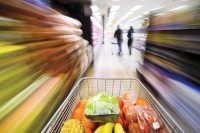 Ipsos Retail Performance is the new name for Synovate Retail Performance, which is now part of Ipsos, the global research group. Completed in October 2011, Ipsos’ acquisition of Synovate confirms Ipsos as one of the world’s largest research providers.
Ipsos Retail Performance is the new name for Synovate Retail Performance, which is now part of Ipsos, the global research group. Completed in October 2011, Ipsos’ acquisition of Synovate confirms Ipsos as one of the world’s largest research providers.
Ipsos Retail Performance is a leading worldwide supplier of scientific footfall monitoring and behavioural analysis systems, providing retailers with Key Performance Indicators to measure, manage and improve customer volume, sales opportunities, conversion rates, staff stretch, promotional activity and in-store layouts. Its core products Shopper Count, Shopper Interact and Shopper Engage scientifically measure all aspects of the shopper experience, from store entry to exit.
Dr Tim Denison, Director of Retail Intelligence at Ipsos Retail Performance, spoke to The Grocery Trader.
The Grocery Trader – First of all, Tim, what does your role as Director of Retail Intelligence involve day to day?
Our business has a very simple mantra: Measure-Manage-Improve. We provide systems to measure a range of ‘front of house’ activities for retailers such as footfall entering stores, the routes shoppers take around the store, staff to shopper ratios, queue lengths and times and so on. By helping retailers to manage these metrics, it leads to performance improvements.
My job is to ensure that these improvements are realised by transforming the data into valuable knowledge and actionable insights. It is not about providing reams of reports or terabytes of data.
GT – Do you get personally involved in working with individual retailers and developing footfall monitoring and analysis programmes for them?
 I spend time with clients to understand their latest challenges and wish lists so that we continually evolve and develop solutions to deliver performance improvement back to them. It’s the most rewarding part of the job, coming up with something new that meets and exceeds what the client thought was possible. Technology is so fast moving nowadays that is it remarkable what can be done that once was little more than a pipe dream.
I spend time with clients to understand their latest challenges and wish lists so that we continually evolve and develop solutions to deliver performance improvement back to them. It’s the most rewarding part of the job, coming up with something new that meets and exceeds what the client thought was possible. Technology is so fast moving nowadays that is it remarkable what can be done that once was little more than a pipe dream.
GT – Where is Ipsos Retail Performance’s UK office? Do you have offices across Europe? Can you service multi-national store groups?
We’re based in Milton Keynes, a great location with many hi-tech companies and a highly skilled talent pool. Ipsos, our new parent company, is global with offices in over 80 countries. We operate directly out of three of these offices outside the UK, servicing Europe, the Americas and the Far East.
One of our fastest growing client segments is the expanding group of European retailers who are extending their global footprint and wanting a common set of performance metrics. We also have a global network of channel partners, building our presence rapidly.
GT – What difference will Ipsos’ acquisition make to your service to your existing customers?
As part of what is now the world’s third largest market research company, we can offer an unparalleled portfolio of solutions for retailers – in-store counting and tracking systems, brand trackers and mystery shopping programmes, integrated shopper insight programmes that track purchase intentions, in-store shopping behaviour and post-purchase evaluation and feedback. Significantly, we can now make these solutions work together to provide smart solutions, drawing insight from one element as input into another.
Our future strategy will also involve investing in and developing new technological solutions. We have recently set up a Product Development office that trawls the world for new concepts, development projects and full-blown solutions that will deliver the future insights our clients are looking for.
GT – How big is Ipsos Retail Performance worldwide?
 Ipsos Retail Performance currently monitors over one billion visits to retail premises per year worldwide and operates in 38 markets across Europe, the Americas and Asia Pacific. We are also recognised as a leading industry commentator.
Ipsos Retail Performance currently monitors over one billion visits to retail premises per year worldwide and operates in 38 markets across Europe, the Americas and Asia Pacific. We are also recognised as a leading industry commentator.
GT – Can you quote figures for the monitoring you do in retail in the UK?
We monitor over 6,500 retail stores in the UK, making us the largest player in our field. Geographically we cover the whole mainland UK from Thirsk to Penzance, covering all main retail centres.
GT – Which different UK retail sectors do you operate in?
We operate in most sectors, including mobile phone stores, jewellery, fashion, finance, department stores, health & beauty and home entertainment. We are building a presence in the fast food sector and with this success are now looking to extend into the convenience and grocery sector.
GT – You mentioned Ipsos being a leading industry commentator. Here in the UK Synovate Retail Performance has been publishing its Retail Traffic Index series for many years, tracking national, regional and sector retail footfall trends. Now that you are Ipsos Retail Performance, will you continue publishing the Index? In the same vein, will you and KPMG continue to run your joint retail think tank?
Benchmarking performance is very valuable to retailers, and the RTI series is very well received by the industry. It was the first in the UK and is one of the trusted bellwethers of retail activity. We will keep the series running, and are looking to add new sector splits this year.
Likewise, the KPMG-Ipsos Retail Think Tank has built a great reputation and following in its six year history. It was established to provide an authoritative, credible and trusted window on what is really happening in retail and develop thought leadership on the key areas influencing the future of retailing in the UK. It is a unique source of insight that retailers cherish and one of which we are very proud.
GT – What specific footfall monitoring services do you provide which are relevant for UK multiple grocers – supermarkets, co-ops and convenience store chains?
Our Shopper Count service provides technology to count shoppers entering shops; Shopper Interact supplies the technology to monitor shopper interaction at an aisle and fixture level; and Shopper Engage uncovers their in-store behaviour and actions. Customer service is becoming increasingly important in the convenience and grocery sector, so aspects of the shopper’s experience such as navigation and queuing times are critical. We continue to add to our portfolio, developing solutions geared at improvements in these areas and beyond.
GT – How do you carry out your monitoring and analysis? Do you use security cameras and electronic sensors, or do you use human observers?
All our monitoring is technology-based, using specialist equipment. It’s the only approach that makes any sense. It has to be robust, accurate and fit-for-purpose, because business decisions are made on the back of it. We invest a lot of time and effort into their development and evaluation, because that’s the only way you get quality output on which dependable insights can be built.
GT – Are you dependent on any particular technology?
 As far as the technology is concerned, there are several types of customer counting technologies available, but because Ipsos Retail Performance is technology-agnostic, we have all bases covered – infrared (active and passive), thermal and video. Each one has its strengths and weaknesses, and we ensure the most appropriate technology is used to address the brief and accommodate the physical environment.
As far as the technology is concerned, there are several types of customer counting technologies available, but because Ipsos Retail Performance is technology-agnostic, we have all bases covered – infrared (active and passive), thermal and video. Each one has its strengths and weaknesses, and we ensure the most appropriate technology is used to address the brief and accommodate the physical environment.
GT – How do you supply the resulting information to your customers? Who within a retail organisation do you supply the data to? Is the data visible to everyone in the business who needs to see it?
Some clients view their reports via a web portal. Dependent on functions and levels within a business, users can log on to see their designated reports. Reports are rolled up from store to company level up through an agreed geographical hierarchy with non-geographical splits. Others choose to receive data via a text file to their data warehouse. Others still want high-level weekly reports, built around defined Key Performance Indicators (KPIs). Usually the information is included in weekly Trading Board packs, but functional owners stretch from Operations, to Marketing, Customer Insight, Finance, Location Planning, IT and even to HR.
The reports are a regular and important touch point but clients also welcome our account management approach, whereby we get together regularly with each client to review performance drivers and share knowledge, supporting the meetings with monthly and quarterly insight packs.
GT – In our introduction we mentioned how your analysis systems provide KPIs to measure customer volume, sales opportunities, conversion rates, staff stretch, promotional activity and in-store layouts. I can see how footfall monitoring measures customer volume, but how does it measure the other factors?
Capturing footfall data is our starting point. By overlaying this with other data streams such as transaction volumes, staff numbers, media spend and till openings, we build these other metrics. Retailers base their analysis on sales, while we focus ours on opportunities.
GT – What difference can your data make to the customer experience that a store delivers?
 There is always scope to build better customer experiences, whether by reducing stock outs or queuing times, positioning staff in key store locations at times when customers want it, or improving navigation and layout so that shoppers can find what they are looking for quickly and easily. Better experiences lead to more sales, so it is a virtuous circle.
There is always scope to build better customer experiences, whether by reducing stock outs or queuing times, positioning staff in key store locations at times when customers want it, or improving navigation and layout so that shoppers can find what they are looking for quickly and easily. Better experiences lead to more sales, so it is a virtuous circle.
GT – Is the demand for customer counting services increasing?
Yes, in the last few years we have seen a growing need for customer counting services among grocers. Traditionally the grocery sector have not been big users of customer counting technologies, because they haven’t always felt it’s relevant to them, unlike the non-food sector. The widely held view in the grocery industry was that any customer walking into a grocery store was simply expected to buy food and drink, so why bother checking their in-store movements and behaviour, other than counting them at the front door?
GT – So what’s changed?
 Firstly, there has been an increase in the level of competition among the big grocers. So as well as what is on the shelf, aspects of the store offering such as customer service have become even more important. A good example of improving customer service is cutting queuing times. Customer counting can be used to provide information about queue management and related areas to help retailers decide whether or not additional tills need to be opened. Another development is that grocers want to make decisions quickly, sometimes immediately. This is made possible through live reporting so that in-store teams can be alerted to any changes that need to be implemented straight away.
Firstly, there has been an increase in the level of competition among the big grocers. So as well as what is on the shelf, aspects of the store offering such as customer service have become even more important. A good example of improving customer service is cutting queuing times. Customer counting can be used to provide information about queue management and related areas to help retailers decide whether or not additional tills need to be opened. Another development is that grocers want to make decisions quickly, sometimes immediately. This is made possible through live reporting so that in-store teams can be alerted to any changes that need to be implemented straight away.
GT – Talking of live reporting, how quickly can store managers get access to the latest customer counting data and make decisions? How does it work – can stores set footfall limits that trigger alarms in the manager’s office?
Everything is possible, but we work closely with our clients to deliver solutions that result in actionable decisions. Our metrics are used as Business Intelligence (BI) and Strategic Decision Support applications, as well as Operational Decision Support. It is in this latter area that clients look for near real time solutions, such as creating in-store queue management dashboards. We work through solutions with our clients to ensure that, on the back of the near real time measurement, in-store operational changes can be made in near real time, to deliver performance improvement.
GT – What difference has the arrival of superstores made to the need for your work?
It’s added to it considerably. As the UK grocers have developed mega stores and extended their range of non-food products, such as televisions, office equipment, clothes and so on, the argument that anyone heading for a grocery store will buy something has now been complicated by the fact that they may not! It’s become increasingly important for grocers to know how customers behave in store, and more specifically how they behave in certain sections of that store – a store within a store, if you like.
GT – Do you also monitor convenience stores?
 Yes we do. Convenience is a growing element of retailing, and one we have particular interest in. Our experience in tracking in-store behaviour gives us tools that are invaluable to the sector. Beyond this grocery multiples can no longer view conversion rate monitoring as not for them, because not everyone entering a convenience store makes a purchase.
Yes we do. Convenience is a growing element of retailing, and one we have particular interest in. Our experience in tracking in-store behaviour gives us tools that are invaluable to the sector. Beyond this grocery multiples can no longer view conversion rate monitoring as not for them, because not everyone entering a convenience store makes a purchase.
GT – What difference has the multiple grocers’ move into convenience stores, following the government’s change of policy on mega stores, made to their demand for your services?
The adage that people will buy from these stores may not apply as it has done in the past, and so there is a need to know things like customer conversion rates.
GT – What sets you apart from other retail research companies – why choose Ipsos Retail Performance?
Inevitably during these challenging times of faltering demand and pressure on margins, retailers are striving to improve operational efficiencies and better understand their shoppers. We find there is strong resonance between their mission and our focus on performance improvement and tracking shopping behaviour. The combination of common goals and our longstanding track record of insight provision through technological innovation keeps us very busy.
GT – How much capacity do you have to take on new customers?
Over the last 12 months we have invested significantly in our teams and processes, and expanding rapidly on a global footing, so we have built far greater capacity into the business. It is even more important in these difficult times for leading retailers to understand their in-store operational effectiveness better and get closer to their customers to build more satisfying in-store experiences. To this end we are investing and expanding.
GT – Can you monitor and compare different stores and parts of the country?
Benchmarking performance across different fascias, store formats, and different geographies is part of retailers’ everyday needs and part of our everyday activities.
GT – Can you monitor promotions within particular parts of a store, in individual stores and regionally across a store chain?
Hot spot analysis is always of interest to clients. Establishing the relationship between in-store location and product sales is a growing part of our business, and we have developed our Shopper Interact service especially to address this need.
GT – What are the steps involved in setting up a store monitoring programme? How quickly can it go live?
 We can be up and running within a matter of weeks, but good planning and well thought through objectives are critical to delivering results, so we don’t recommend rushing in headfirst without a clearly defined project outline.
We can be up and running within a matter of weeks, but good planning and well thought through objectives are critical to delivering results, so we don’t recommend rushing in headfirst without a clearly defined project outline.
GT – Who do people need to call if they want to speak to someone about store monitoring?
Our sales team in Milton Keynes would be delighted to speak to anyone interested in learning more.
GT – Finally, where do you see Ipsos Retail Performance’s work with the multiple grocers going from here?
“Front of house” innovation is at the heart of good grocery retailing. As I have indicated, we are seeing more emphasis being given over to measuring its success and harnessing the performance lift. So we see a very exciting and busy period ahead working with the grocery sector.
Ipsos Retail Performance
UK office: +44 (0) 1908 682 700




Comments are closed.